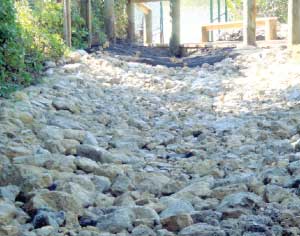Riprap and filter socks were installed at the end of Bayhouse Point Avenue to filter out nutrients entering Little Sarasota Bay.
A Sarasota community has reduced polluted stormwater runoff into Little Sarasota Bay, thanks to a partnership with a neighboring community and the District.
Pelican Cove, a 731-unit condominium community on Little Sarasota Bay, partnered with the District to build a stormwater treatment system to redirect stormwater runoff, reducing the amount of flow and pollutants entering the bay by 80 to 90 percent.
The 82-building development was built in the mid-1970s, before District regulations for stormwater management were developed. The development’s 75 acres include 3,600 feet of shoreline on Little Sarasota Bay and about 4,400 feet of shoreline on Clower Creek, which runs into the bay.
Kevin Richards, who served as Pelican Cove’s general manager during the project’s design and construction, worked to help keep the project on track. “I’m really pleased at how the project turned out,” he said.
“The community just wanted to do something that would have a significant impact on Sarasota Bay. ”
— Kevin Richards
Richards said the idea to partner with the neighboring Portofino on the Bay community began when Portofino and Pelican Cove were negotiating to build docks.
“I walked past a retention pond on their property that was in awful shape,” said Richards. “I knew that we had a stormwater runoff problem, and I got an idea: Fix their pond to handle our runoff. We could help their pond, help us and help the bay.”
Pelican Cove already had a District-approved cooperative funding project for stormwater management. Richards began meeting with the homeowners associations for the two communities, convincing them that sharing the stormwater pond would benefit both communities, and the associations took over. Pelican Cove applied for additional cooperative funding from the District and received funding from the Surface Water Improvement and Management (SWIM) Program and the Manasota Basin Board. Pelican Cove paid for one-half of the project’s $45,000 budgeted cost.
“It didn’t cost Portofino a penny,” said Richards. “The Pelican Cove homeowners association deserves a lot of credit for not worrying about how much it was going to cost to do the right thing. The community just wanted to do something that would have a significant impact on Sarasota Bay.”
The final project included three elements: a bioswale adjacent to the bay to remove silt and pollution from surface runoff water; installation of filter socks at the end of Bayhouse Point Avenue to filter out nutrients; and the modified retention pond on the Portofino property, including an inlet and piping to divert stormwater from Pelican Cove into the pond.
Pelican Cove has been recognized for its work. The community is part of Sarasota’s Neighborhood Environmental Stewardship Team program, consisting of community leaders and residents who volunteer to coordinate projects such as stormdrain markings and pond restorations. In 2008, the community used a District Community Education Grant to complete a project aimed at reducing stormwater pollution in Clower Creek. The community organized a neighborhood planting, installing aquatic and upland plants along the shorelines of neighborhood ponds. In addition, stormdrain skimmer boxes were installed to further reduce harmful runoff. In 2009, the community used a Community Education Grant for a water conservation program that focused on fixing leaking faucets and toilets, which resulted in a savings of 216,000 gallons of water per month.
“The community has been working in many ways to make water quality better,” said Nancy Norton, a professional engineer with the District’s SWIM Program.
Norton said the mature landscaping in the 35-year-old community contributed a lot of leaf litter and other landscaping debris into the bay, and the homeowners association was eager to do something about it.
“With the improvements from this project, material that flows down Bayhouse Point Avenue shouldn’t make it into the bay anymore,” said Norton. “And the community is earnestly interested in doing more. They have been great to work with, and I think this project is much more than just one last hurrah for them.”

